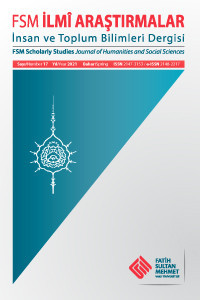Ferdiyetçilik, Kolektivizm ve Sanayi Üçgeninde Sanat ve Zanaat: “Geleneksel Sanatlar” Meselesinin Avrupa’da Yükselişi ve Düşüşü
John Ruskin, Arts and Crafts, Deutsche Werkbund, Bauhaus, geleneksel sanatlar
The Arts and Crafts in the Triangle of Individualism, Collectivism and Industrialism: The Rise and Fall of the “Traditional Arts” Ideal in Europe
John Ruskin, Arts and Crafts, Deutsche Werkbund, Bauhaus, traditional arts,
___
- Bektaş, Dilek, “Sovyet Devrimi’nin Ardından Sanat, Tasarım ve Mimarlık 1917-2017”, Arredamento Mimarlık, (10), 2017. Civelek, Yusuf, “Manifestoların Perspektifinden: Antonio Sant’Elia Fütürist mi?”, Megaron, 10 (4), 2015. Dellaloğlu, Besim F., Romantik Muamma, İstanbul, Bağlam Yayıncılık, 2002. Droste, Magdelena, Bauhaus (1919-1933), Berlin, Benedikt Taschen Verlag, 1998. Frampton, Kenneth, Modern Architecture: A Critical History, New York, Thames and Hudson, 1996. Haddad, Elie G., “On Henry van de Velde’s Manuscript on Ornament” Journal of Design History, 16 (2), 2003. Jarzombek, Mark, “The “Kunstgewerbe”, the “Werkbund”, and the Aesthetics of Culture in the Wilhelmine Period”, Journal of the Society of Architectural Historians, 53 (1), 1994. _______, “Joseph August Lux: Werkbund Promoter, Historian of a Lost Modernity”, The Journal of the Society of Architectural Historians, 63 (2), 2004. Jefferies, Matthew, “Industrial Architecture and Politics In Wilhelmine Germany”, (Yayımlanmamış Doktora Tezi), Oxford University, Londra, 1990. Kentgens-Craig, Margarate, Bauhaus and America. First Contacts 1919- 1936, Cambridge (Mass.), The MIT Press, 1999. Lekan, Thomas, “Regionalism and the Politics of Landscape Preservation in the Third Reich”, Environmental History, 4 (3), 1999. Löwy, Michel, Sayre, Robert, İsyan ve Melankoli: Moderniye Karşı Romantizm, çev. Işık Ergüden, İstanbul, Alfa Yayınları, 2015. Lethaby, William R., Form in Civilization: Collected Papers on Arts & Labour, Londra, Oxford University Press, 1922. Loos, Adolf, “Süsleme ve Suç”, 20. Yüzyıl Mimarisinde Program ve Manifestolar, haz. U. Conrads, Ankara, Şevki Vanlı Vakfı, 1991. Mackmurdo, Arthur Heygate, “The Guild’s Flag Unfurling”, The Century Guild Hobby Horse, 1, 1884. Mallgrave, Harry Francis, Ikonomu, Eleftherios (haz.), Empathy, Form, and Space: Problems in German Aesthetics, 1873 – 1893, Santa Monica, The Getty Center for the History of Art and the Humanities, 1994. Morris, May (haz.), Collected Works of William Morris, c. XV, Londra, Longmans Green and Company, 1912. Pugin, A. Welby, Contrasts: Or Parallel Between the Noble Edifices of the Fourteenth and Fifteenth Centuries, and Similar Buildings of the Present Day; Shewing the Present Decay of Taste, Londra, 1836. _______, The True Principles of Pointed or Christian Architecture, Londra, W. Hughes, 1841. _______, Glossary of Ecclesiastical Ornament and Costume, Londra, Bernard Quaritch,1863. Ruskin, John, The Seven Lamps of Architecture, New York, John Wiley, 1849. _______, The Nature of Gothic – A Chapter of The Stones of Venice, Hammersmith, Kelmscott House, 1892. _______, Fors Clavigera: Letters to the Workmen and Labourers of Great Britain, Londra, George Allen, 1907. Tavernor, Robert, “Introduction”, Andrea Palladio – The Four Books on Architecture, çev. Robert Tavernor & R. Schofield, Cambridge (Mass.), The MIT Press, 1997. Troy, Nancy, Modernism and the Decorative Arts in France: Art Nouveau to Le Corbusier, New Haven & Londra, Yale University Press, 1991. Umbach, Maiken, “The Vernacular International: Heimat, Modernism and the Global Market in Early Twentieth-Century Germany”, National Identities, 4 (1), 2002. Wright, Frank Lloyd, “The Art and Craft of the Machine”, The New Industrialism - Volume I: National League of Industrial Art, 1902.
- ISSN: 2147-3153
- Başlangıç: 2012
- Yayıncı: Fatih Sultan Mehmet Vakıf Üniversitesi
Babacan Liderliğin Psikolojik İyi Olmaya Etkisinde İşin Anlamlılığının Aracılık Rolü
Canan ÇETİN, Nilüfer VATANSEVER TOYLAN, Öznur AYDINER ÇAKIREL, Yasin ÇAKIREL
Vahyedilişinden Derlenişine Kur’an Tarihi, Eski ve Yeni Ahit ile Karşılaştırmalı Bir Araştırma
“Sîreti Sûrette Görmek-I: Kurmaca Dünyada Hz. Peygamber’i Yazmak”
Kenan Ziya Taş, Osmanlının Son Cihan Projesi Kudüs Selâhaddin Eyyübî Külliye-i İslamiyesi
Halil İnalcık, Halil İnalcık’ın Merceğinden Osmanlı
Uluslararası 1877-1878 Osmanlı-Rus Harbinin 140. Yılında Kafkas Göçleri ve Etkileri Sempozyumu
100. Yılında Uluslararası Bağdat (Medînetü’s-Selâm) ve Kûtü’l-Amâre Sempozyumu
Bir Eleştirinin Eleştirisi Mehmet Aydın, “Yayın Değerlendirme”
